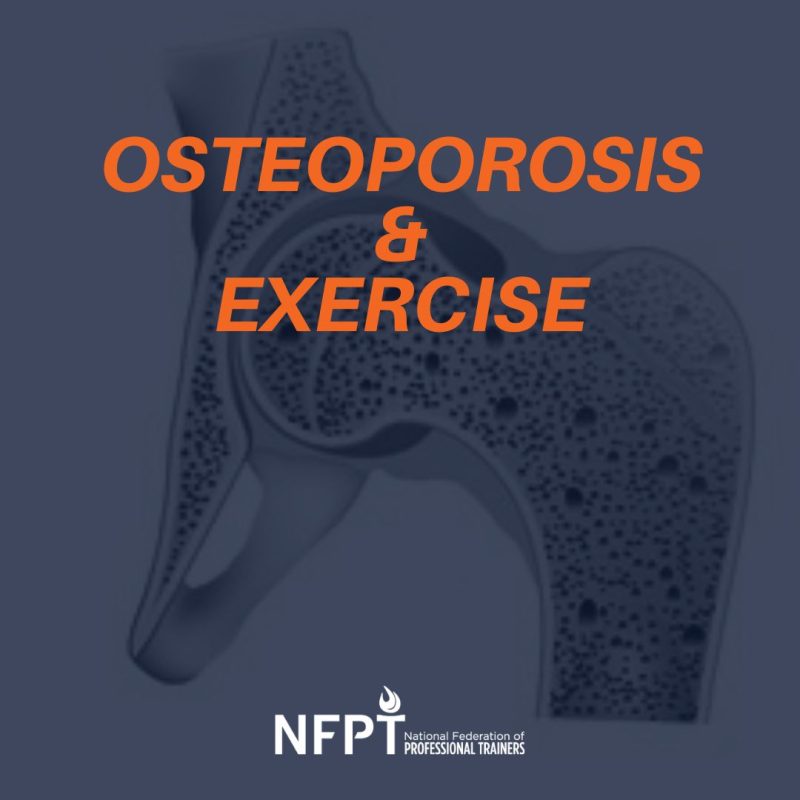
Osteoporosis is a disease that affects millions of people globally and is characterized by weak bones and a high risk of fractures. As a certified personal trainer, it’s important to understand the impact of this bone disease and how to best support clients who may be affected. In this blog, we will explore everything personal trainers need to know about osteoporosis.
Definition and Prevalence of Osteoporosis
Osteoporosis is a condition in which the bones become porous, brittle, and more likely to fracture. The word osteoporosis literally means “porous bones.”
Bonnick1 further defines it as “a systemic skeletal disease characterized by low bone mass and micro-architectural deterioration of bone tissue with a consequent increase in bone frailty and susceptibility to fracture.” These types of fractures are called fragility fractures and are most common in the hip and the spine. The fractures are usually due to bone being subjected to a forceful blow, as in a fall.
This newer definition has evolved due to the technology in bone densitometry that is able to detect changes in the amount of bone as small as 1.5 percent. A woman is at risk for fracture when she has lost approximately 20 percent of her bone mass. The more bone lost, the greater the risk of fracture.
A 50-year-old Caucasian woman today has a 54 percent chance of having an osteoporosis-related fracture in her lifetime.
The condition is most commonly diagnosed in postmenopausal women, but it can also affect men and women of all ages. According to the Bone Health and Osteoporosis Foundation, approximately 10 million Americans have osteoporosis while another 44 million have low bone mass; it is estimated that 80% of those with the disease are women.
Fixed risks for Osteoporosis
Although these risks are fixed and not much we can do as trainers to help there are precautions that can be taken to reduce bone mineral loss.
- Age – Risk becomes greater with age
- Gender – Women are at higher risk
- Family History
- Previous Fractures
- Ethnicity – Asian and Caucasians are at higher risk
- Menopause
- Rheumatoid Arthritis
Exercise and Osteoporosis
Strength training is particularly effective in preventing osteoporosis and building bone density. This type of exercise stimulates bone growth by placing stress on the bones, which triggers the body to respond by building more bone tissue. Resistance exercises that use resistance bands, free weights, or machines can help improve strength and balance, which can reduce the risk of falls and fractures.
Aerobic exercise is also an important component of a prevention program. This type of exercise helps maintain good cardiovascular health and improves circulation, which helps deliver vital nutrients to the bones. It can also help improve balance, coordination, and flexibility, reducing the risk of falls and fractures.
When working with osteoporitic clients, personal trainers should be cautious of exercises that put too much stress on the bones. Instead, trainers should encourage low-impact exercises, such as yoga, tai chi, and swimming, which can help build and maintain strength without putting excessive stress on the bones.
Osteoporosis Exercise Program Goals for Prevention
The following are goals for osteoporosis prevention:
- Maintain bone mass
- Prevent bone loss due to aging
- Maintain joint mobility
- Improve coordination
- Improve posture
- Increase muscle strength and endurance
- Maintain correct postural alignment
- Attain cardiorespiratory fitness
- Reduce risk of falling
Exercise may also have positive benefits, however, certain contraindications are involved while training clients with diagnosed osteoporosis:
- Omit exercises that flex the spine (bending forward at the waist) for clients with spinal bone degeneration. Sinaki2 found that trunk flexion exercises increased the rate of spinal fracture by 89 percent, compared with a 16 percent fracture rate in the back extension group. This means omit crunches, abdominal curls, and rowing machines.
- Avoid bringing the knee to the chest, as this may compromise the spine.
- Avoid activities or movements that place clients at risk for falling. This includes exercising on slick floors, step aerobics, quick directional changes.
- Avoid high-impact, jarring, jumping, or jogging activities. This can increase the risk of spinal fracture, as weakened vertebrae cannot tolerate this force.
- Avoid pulling the neck forward if hands are placed behind the head.
Some women have been advised not to exercise after an osteoporotic fracture. However, no exercise only perpetuates osteoporosis and will result in an overall decline in health. The primary objective is to exercise safely.
Nutrition
Proper nutrition is an essential component in maintaining strong bones. A diet rich in calcium and vitamin D is crucial for optimal bone health and can help slow down the progression of osteoporosis.
Calcium is a key mineral for building and maintaining strong bones, and it’s essential for many functions in the body. The recommended daily intake of calcium for adults is 1000-1300 mg per day, and it can be obtained through dairy products such as milk, cheese, and yogurt, as well as leafy greens such as kale and spinach, and almonds. However, note that the proper ratio of calcium and magnesium is necessary for the minerals to work optimally in the body; a 2 to 1 ratio of calcium to magnesium is recommended.
Vitamin D is equally important for bone health as it helps the body absorb calcium. The recommended daily intake of vitamin D for adults is 600-800 IU per day. Vitamin D can be obtained from sunlight, fatty fish such as salmon and mackerel, and fortified foods such as milk, orange juice, and cereal. It’s important to note that adequate exposure to sunlight may not be possible for everyone, particularly during the winter months, making it essential to include vitamin D-rich foods in the diet.
Summary
In conclusion, as a personal trainer, it’s important to understand the impact of osteoporosis and how to best support clients who may be affected. Exercise plays a crucial role in preventing and managing bone loss and weight-bearing and resistance exercises are particularly effective for maintaining strong bones. In addition to exercise, a diet rich in calcium and vitamin D is crucial for optimal bone health. When working with clients with osteoporosis, personal trainers should encourage low-impact exercises and be cautious of high-impact activities that put excessive stress on the bones.
PS: If you liked this blog, feel free to check out my range of CEUs for Personal Trainers
References
- Sydney, L. The Osteoporosis Handbook -Every Woman’s Guide to Prevention and Treatment. Taylor Publishing, 1997.
- Sinaki, M. 1988. Osteoporosis: Etiology, Diagnosis. Raven Press, New York. 457-465.






